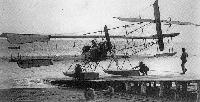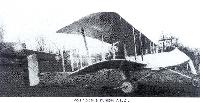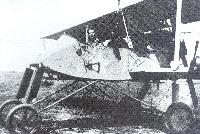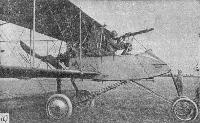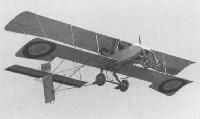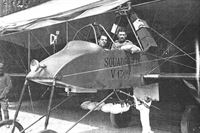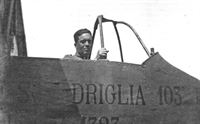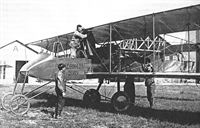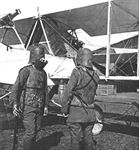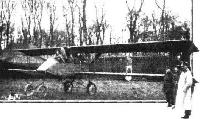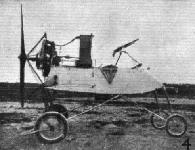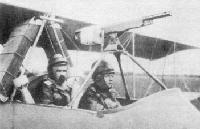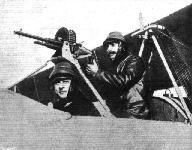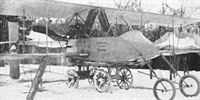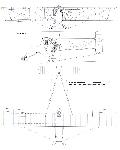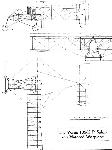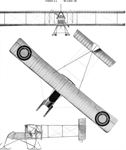
Описание
Страна: Франция
Год: 1913
Фронтовой самолет
Варианты
- Voisin - 3/5 (L/LA/LAS) - 1913 - Франция
- Анатра - Вуазен Иванова - 1916 - Россия
- Ольховский В.М. - Вуазен - 1916 - Россия
- В.Кондратьев Самолеты первой мировой войны
- А.Шепс Самолеты Первой мировой войны. Страны Антанты
- В.Шавров История конструкций самолетов в СССР до 1938 г.
- J.Davilla, A.Soltan French Aircraft of the First World War (Flying Machines)
- A.Durkota, T.Darcey, V.Kulikov The Imperial Russian Air Service (Flying Machines)
- L.Opdyke French Aeroplanes Before the Great War (Schiffer)
- O.Thetford British Naval Aircraft since 1912 (Putnam)
- J.Davilla Italian Aviation in the First World War. Vol.3: Aircraft M-W (A Centennial Perspective on Great War Airplanes 75)
- Сайт Pilots-and-planes
- Журнал Flight
-
В.Кондратьев - Самолеты первой мировой войны
Voisin LAS - ВВС Франции, 1915г.
-
D.Mechin - Oriental Adventures of the French Air force 1914-1918 /Aeronaut/
Voisin LAS no 1013 of Corporal Rene Vicaire, V 90 S squadron, winter 1915-1916.
-
D.Mechin - Oriental Adventures of the French Air force 1914-1918 /Aeronaut/
Voisin LAS no 1100 from escadrille V 90 during the first half of 1916. The red pennant was also painted on the top of right wing.
-
D.Mechin - Foreign Fronts of the French Air Force 1914-1919 /Aeronaut/
10 worn-out Voisin LAS from the Air Depots of Armee d'Orient: that's all Indochina received during the war. The two little escadrilles formed, one near Hanoi and one in Saigon (today Ho Chi Minh City), could make only very few flights.
-
D.Mechin - Oriental Adventures of the French Air force 1914-1918 /Aeronaut/
Voisin LAS (serial unknown) of escadrille V 83 in 1916. The smiley in the star is an unofficial marking.
-
А.Шепс - Самолеты Первой мировой войны. Страны Антанты
Разведчик/легкий бомбардировщик "Вуазен-III LA"
-
D.Mechin - Oriental Adventures of the French Air force 1914-1918 /Aeronaut/
Voisin "13,50 m" no V.6 of Lieutenant de vaisseau Emile Janvier, Antivari (Montenegro) September 1914. (David Mechin)
-
А.Шепс - Самолеты Первой мировой войны. Страны Антанты
Разведчик/легкий бомбардировщик "Вуазен-V LAS" российской армии
-
R.Gentilli - Italian Aviation Units in the First World War. Vol.1 /Aeronaut/ (1)
Voisin III V.378, 5a Squadriglia, 1915
-
R.Gentilli - Italian Aviation Units in the First World War. Vol.1 /Aeronaut/ (1)
Voisin III V.589, 7a Squadriglia, Late 1915
-
J.Davilla - Italian Aviation in the First World War. Vol.3: Aircraft M-W /Centennial Perspective/ (75)
Voisin III V.603, 26a Squadriglia
-
R.Gentilli - Italian Aviation Units in the First World War. Vol.1 /Aeronaut/ (1)
Voisin III V.608, 7a Squadriglia, 1916
-
R.Gentilli - Italian Aviation Units in the First World War. Vol.2 /Aeronaut/ (2)
Voisin III #659, 26a Squadriglia
-
J.Davilla - Italian Aviation in the First World War. Vol.3: Aircraft M-W /Centennial Perspective/ (75)
Voisin III V.1296, 25a Squadriglia
-
J.Davilla - Italian Aviation in the First World War. Vol.3: Aircraft M-W /Centennial Perspective/ (75)
Voisin III V.1441, 35a Squadriglia
-
R.Gentilli - Italian Aviation Units in the First World War. Vol.2 /Aeronaut/ (2)
Voisin, 25a Squadriglia
-
D.Mechin - Foreign Fronts of the French Air Force 1914-1919 /Aeronaut/
Voisin LA of the Corpul de Aviatie in 1916.
-
L.Opdyke - French Aeroplanes Before the Great War /Schiffer/
In February 1913, the prototype of what would become the Voisin 13.5-Meter, the forerunner of most of the wartime Voisin pushers.
-
L.Opdyke - French Aeroplanes Before the Great War /Schiffer/
The 13.5-Meter Voisin of 1913. Note the extension shaft.
-
J.Davilla, A.Soltan - French Aircraft of the First World War /Flying Machines/
Voisin L armed with a Hotchkiss machine gun. A spare propeller is mounted on the left side of the fuselage.
-
J.Davilla, A.Soltan - French Aircraft of the First World War /Flying Machines/
Voisin 1913 (Type L) with an 80-hp Le Rhone 9C engine at the 1913 military maneuvers.
-
Jane's All The World Aircraft 1919 /Jane's/
Voisin III light bomber of 1914, with a Canton-Unne engine. A Type III was the first French aircraft to bring down a German aircraft, on 5 October 1914.
-
L.Opdyke - French Aeroplanes Before the Great War /Schiffer/
The Voisin 1L. Its lineage is pretty clear
-
J.Davilla, A.Soltan - French Aircraft of the First World War /Flying Machines/
Voisin L floatplane of the Aviation Maritime. The Aviation Maritime had several Voisin Ls on strength at the Boulogne and Dunkirk bases. Reairche.
-
L.Opdyke - French Aeroplanes Before the Great War /Schiffer/
A 13.5-Meter Voisin on floats for the French Navy.
-
A.Olejko - Habsburg Wings 1915 /Aeronaut/
The time of testing foreign flying equipment showed that the KuK Seeflugwessen did not adopt floatplanes... The photo shows the French type Voisin L floatplane No. 14 during the trials at the Versuchflugstation KuK Seeflugwessen on the island of St. Catarina - Source: P. Schupita, Die kuk Seeflieger. Chronik Und Dokumentation osterreichiszch-ungarischen Marineluftwaffe 1911-1918, Koblenz 1983.
-
D.Mechin - Oriental Adventures of the French Air force 1914-1918 /Aeronaut/
Bucolic image of the Voisin seaplane no V.6 of LV Janvier moored at Antivari. The appearances are deceptive: the wind of the Adriatic, the Bura, proves to be formidable and will quickly get the better of the frail French aircraft, which was which will find itself embedded on the roof of a house... Nothing being wasted among French sailors, the half destroyed aircraft recovered, brought back to France France and repaired, ending its career as a land bomber at Dunkirk in 1915! (Collection Boris Ciglic)
-
J.Davilla, A.Soltan - French Aircraft of the First World War /Flying Machines/
Voisin 3 (LA) serial V.499 at the Ecole d'Aviation at Amberieu.
-
J.Davilla, A.Soltan - French Aircraft of the First World War /Flying Machines/
Voisin L piloted by Adjudant Possi.
-
J.Davilla, A.Soltan - French Aircraft of the First World War /Flying Machines/
Voisin 3 (LA) serial V.443.
-
J.Davilla, A.Soltan - French Aircraft of the First World War /Flying Machines/
Voisin 3 The ground crew is loading the aircraft with bombs.
-
J.Davilla, A.Soltan - French Aircraft of the First World War /Flying Machines/
Voisin 3 with machine gun mounted in the nose.
-
J.Davilla, A.Soltan - French Aircraft of the First World War /Flying Machines/
Voisin 3 (probably an LA) armed with lance bombs in the container mounted on the fuselage side. Windows were fitted in the floor of the nacelle to improve the crew's downward view.
-
Журнал - Flight за 1915 г.
Nacelle of the Voisin fighting biplane. Note the bomb-dropping arrangement on the side.
-
J.Davilla, A.Soltan - French Aircraft of the First World War /Flying Machines/
Voisin 3 (LAS) serial V.685 of the ecole d'Aviation at Amberieu; its elevated engine mount is visible.
-
Сайт - Pilots-and-planes /WWW/
Voisin 5 serial number V.1310
-
Сайт - Pilots-and-planes /WWW/
Voisin 5 serial number V.1321
-
Сайт - Pilots-and-planes /WWW/
Вид на кабину экипажа Вуазена LA. Пилот самолета сидит под треногой с пулеметом "Кольт". В задней кабине летчик-наблюдатель держит пару авиабомб. Позади него возвышаются короба водорадиаторов.
-
J.Davilla, A.Soltan - French Aircraft of the First World War /Flying Machines/
Voisin 3 of VB 103, which was assigned to G8 1.
-
Сайт - Pilots-and-planes /WWW/
Voisin 5. This aircraft was a Voisin 3 airframe fitted with a 150-hp Salmson P9 engine, a streamlined nacelle, strengthened landing gear, and a wing chord which increased from the roots to the wing tips.
-
D.Mechin - Oriental Adventures of the French Air force 1914-1918 /Aeronaut/
Voisin LAS nicknamed Ninochka, flow by Russian pilot Alexandre Gomberg and Lt Jacques Richepin from V 90 S. This crew was shot down by a German Fokker E on March 24,1916, but could land in no-man's-land and walk back to French line after putting their plane on fire.
-
D.Mechin - Oriental Adventures of the French Air force 1914-1918 /Aeronaut/
Like his brother Jacques, Tiarko Richepin, seen here in front of Voisin LAS no 1100, served in escadrille V 90.
-
A.Durkota, T.Darcey, V.Kulikov - The Imperial Russian Air Service /Flying Machines/
Lineup of the Voisins of escadrille VB.102, Malzeville, winter 1915-16. Coudouret served in this unit with distinction throughout the latter half of 1915 and early 1916, participating in many bombing raids.
-
J.Davilla, A.Soltan - French Aircraft of the First World War /Flying Machines/
Voisin 3 (LAS). Renaud.
-
D.Mechin - Oriental Adventures of the French Air force 1914-1918 /Aeronaut/
Adjudant Jean Faure, despite being aged 58, flew operationally with escadrille V 83 in 1916.
-
D.Mechin - Oriental Adventures of the French Air force 1914-1918 /Aeronaut/
Voisin LAS from escadrille V 90 S in early 1916.
-
D.Mechin - Oriental Adventures of the French Air force 1914-1918 /Aeronaut/
Voisin LAS belonging to the commanding officer of V 83, Capitaine Gaston de Serre.
-
D.Mechin - Oriental Adventures of the French Air force 1914-1918 /Aeronaut/
Greek civilians and soldiers observe a Voisin LAS of the V 90 S squadron mounted at camp Allatini, the maneuvering field located south of the city of Salonica, which will house the entire Oriental Aviation Park. (DR)
-
D.Mechin - Oriental Adventures of the French Air force 1914-1918 /Aeronaut/
The Voisin LAS of the V 90 S squadron stationed in the snow on the field of coast 262, south of Krivolak, during the Vardar expedition in November 1915. (Coll. Albin Denis)
-
A.Durkota, T.Darcey, V.Kulikov - The Imperial Russian Air Service /Flying Machines/
A Franco-Romanian Farman escadrila with a mixed group of Romanian, French, and Russian crew members. Notice the different styles of uniforms. The Russian officer third from the left appears to be wearing the Order of St George Fourth Class and the Russian fifth from the left is wearing an officer's derrick. The aircraft on the left is a Farman F.40, while the aircraft on the right is a Voisin. The two machine guns are captured Austrian Schwarzlose guns.
Другие самолёты на фотографии: Farman F.40 - Франция - 1915
-
D.Mechin - Oriental Adventures of the French Air force 1914-1918 /Aeronaut/
A Voisin LAS with the red markings of the V 90 S squadron, photographed during a mission to bomb enemy camps in early 1916. (DR)
-
D.Mechin - Oriental Adventures of the French Air force 1914-1918 /Aeronaut/
Voisin LAS no 1100 from escadrille V 90, one of the 3 units of Groupe de Bombardement d'Orient (GBO) in early 1916.
-
В.Кондратьев - Самолеты первой мировой войны
"Вуазен LAS" русских ВВС
-
A.Durkota, T.Darcey, V.Kulikov - The Imperial Russian Air Service /Flying Machines/
Voisin LA. Although the aircraft appeared fragile, its structure was quite sturdy by 1915-16 standards.
-
A.Durkota, T.Darcey, V.Kulikov - The Imperial Russian Air Service /Flying Machines/
The standard mount of many observation units, the Voisin LA (type 3), equipped with the Salmson (Canton-Unne) 120hp water-cooled radial engine. Many were supplied to Russia by France and several were built under license by the Dux factory. There are tall box-type radiators behind the crew's compartment and two gun mounts. In front is a tripod for a forward-firing gun and the long pole that concludes at the leading edge of the upper wing to mount a machine gun for rearward fire.
-
J.Davilla, A.Soltan - French Aircraft of the First World War /Flying Machines/
Voisin 3 (LAS) in IRAS service. Via Colin Owers.
-
J.Davilla, A.Soltan - French Aircraft of the First World War /Flying Machines/
Voisin 3 (LAS) in IRAS service. Via Colin Owers.
-
A.Durkota, T.Darcey, V.Kulikov - The Imperial Russian Air Service /Flying Machines/
Another important aircraft used by the corps detachments was the Voisin L series, This Dux-built Voisin LA shows the two boxed radiators for the Salmson engine. Although no machine guns are fitted, both mounting brackets are in place, one over the pilot and one at the leading edge of the upper wing, If the two guns were installed, the observer could fire forward and behind his aircraft, Unfortunately, he had to do this while standing, The Dux roundel is evident as well as the information table stenciled on the nose, It reads "Maximum load 350 kilograms."
-
A.Durkota, T.Darcey, V.Kulikov - The Imperial Russian Air Service /Flying Machines/
Voisin LA with pilot Jan Dzikowski. This type of aircraft was produced in many Russian factories and also imported from French manufacturers.
-
H.Nowarra, G.Duval - Russian Civil and Military Aircraft 1884-1969
Voisin LA is examined by German personnel
-
A.Durkota, T.Darcey, V.Kulikov - The Imperial Russian Air Service /Flying Machines/
Praporshik Olgerts Teteris displaying his pilot's badge and one NCO award of the Cross of Saint George (wearing his cap tipped to his right and seated behind the man holding the tray), surrounded by his fellow members of the 13th Corps Detachment with one of the unit's Voisins. It appears the tray is filled with pastries and may be the occasion of Teteris' commission on December 2, 1916. On some of the NCOs' pogoni (shoulderboards), the roman numeral XIII can be seen, designating the 13th Detachment. Almost all are NCOs or enlisted men, with whom Teteris probably had greater friendships than he did with officers.
-
A.Durkota, T.Darcey, V.Kulikov - The Imperial Russian Air Service /Flying Machines/
Members of the 25th Corps Detachment with one of the unit's Voisins during the summer of 1916. Sergievsky is standing fourth from the left and is displaying his Order of Saint George Fourth Class, earned for action in the infantry. It is believed that Poruchik Khoodjakov is seated in the forward position of the Voisin. Others unidentified.
-
A.Durkota, T.Darcey, V.Kulikov - The Imperial Russian Air Service /Flying Machines/
A Russian Voisin LA, winter 1915-1916. Orlov conducted most of his reconnaissance missions in this type of aircraft.
-
J.Davilla, A.Soltan - French Aircraft of the First World War /Flying Machines/
Voisin 3 of the IRAS assigned to the 21st Escadrille.
-
A.Durkota, T.Darcey, V.Kulikov - The Imperial Russian Air Service /Flying Machines/
A Voisin LA. Kruten's first victory was obtained in this type of aircraft on March 6, 1915. This photograph shows the unusual firing position the observer used to aim behind the aircraft.
-
H.Nowarra, G.Duval - Russian Civil and Military Aircraft 1884-1969
Early tricycle - a Voisin LA with winter undercarriage. The high gloss visible on the wing fabric is caused by weather-protective varnish.
-
J.Davilla, A.Soltan - French Aircraft of the First World War /Flying Machines/
Voisin 3 (LAS) in IRAS service. Via Colin Owers.
-
D.Mechin - Foreign Fronts of the French Air Force 1914-1919 /Aeronaut/
The French pilots and observers of the Berger mission are distributed among the Russian squadrons, where they discover very rustic living conditions. Second Lieutenant Boittiaux photographed this Voisin LAS stuck in what seems to be a barely thawed pond. (Leon Boittiaux, coll. Albin Denis)
-
A.Durkota, T.Darcey, V.Kulikov - The Imperial Russian Air Service /Flying Machines/
A Voisin in flight, most likely at a training facility. Bagrovnikov learned to fly Voisins at the Sevastopol Aviation School in 1916, and flew this type for the remainder of the war. He earned his only victory in this type on July 20, 1917, while commanding the 9th Army Air Detachment.
-
A.Durkota, T.Darcey, V.Kulikov - The Imperial Russian Air Service /Flying Machines/
The standard mount of many corps units, the slow but sturdy Voisin, which was still flying when the war ended for Russia. The crews of these planes provided faithful service, demanding the most from their tired machines. Together these aviators and aircraft made commendable teams.
-
A.Durkota, T.Darcey, V.Kulikov - The Imperial Russian Air Service /Flying Machines/
A standard forward area army park showing aircraft being repaired for their return to service with frontline detachments. A captured Albatros (Rumpler ???) is in the foreground, with a Morane-Saulnier L behind it. Nieuport IV fuselages and Voisin nacelles are also visible.
Другие самолёты на фотографии: Morane-Saulnier Type L / Моран-Парасоль - Франция - 1913Nieuport Nieuport-IV - Франция - 1911Rumpler B.I/4A - Германия - 1914
-
J.Davilla, A.Soltan - French Aircraft of the First World War /Flying Machines/
Experimental conversion of a Voisin produced in Russia. This may be the Ivanov Voisin described under the section on the Voisin 5.
-
D.Mechin - Oriental Adventures of the French Air force 1914-1918 /Aeronaut/
A Voisin LAS bomber from the RNAS. British planes in Gallipoli were wearing French cockades.
-
K.Delve - World War One in the Air /Crowood/
The series of Voisin pusher-engined, two seaters initially entered service with the French prior to the war and through improvements continued to flow into service through to early 1918. The Voisin LA, or Type III, depicted here, entered service in early 1915 and used a 130hp Salmson-built Canton-Unne 9M. The Type III's top level speed was a modest 76mph at 6.560 feet. The machine carried a 460lb bombload over a range of 250 miles at a cruising speed of 59mph. By way of defence one Hotchkiss or one Lewis gun was mounted forward. Built in quantity, the Type III was used by France, Belgium, Russia and Britain's RNAS, an example of which is seen here, operating from the northeastern Aegean island of Imbros during the early summer of 1915.
-
Jane's All The World Aircraft 1919 /Jane's/
S.I.T.-Voisin III with 130 h.p. Salmson (Canton-Unne) engine.
-
R.Gentilli - Italian Aviation Units in the First World War. Vol.1 /Aeronaut/ (1)
Voisin 378 in marked "XVIa Squadriglia" but when this unit became operational it was named 5a Squadriglia.
-
R.Gentilli - Italian Aviation Units in the First World War. Vol.1 /Aeronaut/ (1)
Voisin 380 of the 5a Squadriglia, unarmed but with a tube for dropping bombs, a device that disappeared quickly. (Archive Salvo Di Marco)
-
R.Gentilli - Italian Aviation Units in the First World War. Vol.1 /Aeronaut/ (1)
Voisin 381 of the 5a Squadriglia, bombs are laying on the ground. (Archive Caliaro)
-
K.Delve - World War One in the Air /Crowood/
It was a similar story with Italian aviation: a reliance on foreign types, other than the excellent Caproni bombers. The air war was slow to develop between the Italians and Austrians due to an lack of an effective air organization. This Voisin was in service with 7a Squadriglia.
-
R.Gentilli - Italian Aviation Units in the First World War. Vol.1 /Aeronaut/ (1)
Voisin 3 V.589 of the 7a Squadriglia being prepared for a mission, soldiers are attaching fins to a 162-mm bomb. (Archive Caliaro)
-
R.Gentilli - Italian Aviation Units in the First World War. Vol.1 /Aeronaut/ (1)
The same Voisin 589 ready to fly; a Fiat 1914 machine gun is fitted on the front tripod. (Archive Caliaro)
-
R.Gentilli - Italian Aviation Units in the First World War. Vol.2 /Aeronaut/ (2)
Baracchini leaning from the cockpit of Voisin 659.
-
R.Gentilli - Italian Aviation Units in the First World War. Vol.1 /Aeronaut/ (1)
Voisin 590 and 585 of the 7a Squadriglia.
-
R.Gentilli - Italian Aviation Units in the First World War. Vol.1 /Aeronaut/ (1)
Voisin 608, here still in the field of its manufacturer, SIT in Turin, was assigned to the 7a Squadriglia, on its fuselage the construction number, 143, is marked with chalk.
-
R.Gentilli - Italian Aviation Units in the First World War. Vol.2 /Aeronaut/ (2)
The playful photographs of the airmen of the 25a Squadriglia are proof of the high morale and esprit de corps of this outstanding unit.
-
R.Gentilli - Italian Aviation Units in the First World War. Vol.2 /Aeronaut/ (2)
A line-up of Voisins at Pozzuolo del Friuli.
-
J.Davilla - Italian Aviation in the First World War. Vol.3: Aircraft M-W /Centennial Perspective/ (75)
Voisin 3 V.1309 with crew and bombload.
-
R.Gentilli - Italian Aviation Units in the First World War. Vol.2 /Aeronaut/ (2)
A Voisin with Isotta Fraschini engine of 25a Squadriglia with a full load of bombs and a Fiat and Villar Perosa guns. (Archive Caliaro)
-
R.Gentilli - Italian Aviation Units in the First World War. Vol.3 /Aeronaut/ (3)
Voisin 1322 of the 105a Squadriglia, here pictured on a visit to the flying school of San Giusto, Pisa.
-
H.Cowin - Aviation Pioneers /Osprey/
An Italian operated Voisin LA, the machine being licence-built by SIT in substantial quantities throughout late 1915 and 1916. This particular aircraft used a 190hp Isotta-Fraschini V 4B. These lumbering, pusher-engined reconnaissance machines proved easy prey for the Austro-Hungarian fighters.
-
R.Gentilli - Italian Aviation Units in the First World War. Vol.5 /Aeronaut/ (5)
Voisin 1441 of the Sezione of Cairo Montenotte. (Comune di Cairo Montenotte)
-
J.Davilla - Italian Aviation in the First World War. Vol.3: Aircraft M-W /Centennial Perspective/ (75)
Closeup of pilot in Voisin V.1797 of 103a Squadriglia.
-
R.Gentilli - Italian Aviation Units in the First World War. Vol.3 /Aeronaut/ (3)
Voisin 2087 of the 103a Squadriglia with the crew of gunner sold. Dario Mazzarella and pilot serg. Arturo Foa.
-
J.Davilla - Italian Aviation in the First World War. Vol.3: Aircraft M-W /Centennial Perspective/ (75)
Voisin 3 V.2089 being readied for a mission.
-
R.Gentilli - Italian Aviation Units in the First World War. Vol.2 /Aeronaut/ (2)
Voisin 2094 with Canton Unne engine of the 35a Squadriglia. The airmen are holding 162-mm 50 pound bombs. (Archive Caliaro)
-
R.Gentilli - Italian Aviation Units in the First World War. Vol.5 /Aeronaut/ (5)
Old Voisins collected at Marcon airfield for the secret missions of the Squadriglia Mista.
-
R.Gentilli - Italian Aviation Units in the First World War. Vol.5 /Aeronaut/ (5)
A Voisin of the Sezione Difesa of Novi Ligure carrying flowers to be dropped to honor the victims of a railroad disaster, 5 August 1917.
-
R.Gentilli - Italian Aviation Units in the First World War. Vol.2 /Aeronaut/ (2)
A group of high officers visits the 25a Squadriglia; the Voisin behind them carries no gun, but in front of the cockpit there is a good luck charm doll.
-
R.Gentilli - Italian Aviation Units in the First World War. Vol.2 /Aeronaut/ (2)
Officers of the 25a Squadriglia with a Voisin marked with a white band.
-
R.Gentilli - Italian Aviation Units in the First World War. Vol.2 /Aeronaut/ (2)
Gabriele d'Annunzio with the airmen of the 25a Squadriglia.
-
R.Gentilli - Italian Aviation Units in the First World War. Vol.2 /Aeronaut/ (2)
Commander Calleri Di Sala and other airmen in front of a late-production Voisin, serial 208?, with Canton Unne engine. (Archive Caliaro)
-
R.Gentilli - Italian Aviation Units in the First World War. Vol.2 /Aeronaut/ (2)
Massimo Adolfo Vitale, a Jew, was a veteran of the Libyan war. Later he was commander of the flying school at Gioia del Colle, using Voisins, and then creator of the Italian Air Force in the colonies of Somalia and Eritrea. He left Italy in 1938, returned in 1945, and created a network for the search of information on Italian Jews victims of the Holocaust.
-
R.Gentilli - Italian Aviation Units in the First World War. Vol.2 /Aeronaut/ (2)
A Voisin with Canton Unne engine of 25a Squadriglia at Santa Maria La Longa.
-
R.Gentilli - Italian Aviation Units in the First World War. Vol.2 /Aeronaut/ (2)
S.ten. Luciano Bianchi flew Gabriele d'Annunzio at the 25a Squadriglia. In the cockpit of the Voisin there is a bullet hole with the caption "Nabresina 13 January 1916".
-
R.Gentilli - Italian Aviation Units in the First World War. Vol.5 /Aeronaut/ (5)
At the flying school of Mirafiori, a Voisin with an unusual rotary engine. (Archive Schifano)
-
R.Gentilli - Italian Aviation Units in the First World War. Vol.3 /Aeronaut/ (3)
A Voisin of the 105a Squadriglia. Four soldiers are showing their empty pockets.
-
R.Gentilli - Italian Aviation Units in the First World War. Vol.5 /Aeronaut/ (5)
Gino Allegri began his career at the Sezione Difesa of Cairo Montenotte; he died flying with the 87a Squadriglia "Serenissima" and was awarded the Gold Medal for Valor. The photo is signed "L'amico pipistrello" your friend the bat.
-
R.Gentilli - Italian Aviation Units in the First World War. Vol.3 /Aeronaut/ (3)
Serg.m. Franco Macchi, with the Canton Unne engine of a Voisin, in a photo for his friend Felice Trojani. Due to a bureaucratic mix-up, he was assigned the honor and prizes of the deceased Fermo Macchi.
-
J.Davilla - Italian Aviation in the First World War. Vol.3: Aircraft M-W /Centennial Perspective/ (75)
Voisin 3 with crew wearing primitive armor. The armor was not generally used.
-
R.Gentilli - Italian Aviation Units in the First World War. Vol.2 /Aeronaut/ (2)
Airmen of the 35a Squadriglia wearing helms and armor, an equipment that was immediately rejected.
-
R.Gentilli - Italian Aviation Units in the First World War. Vol.2 /Aeronaut/ (2)
Captain Minellono testing, and rejecting, the steel armor and helm offered to airmen.
-
R.Gentilli - Italian Aviation Units in the First World War. Vol.2 /Aeronaut/ (2)
Voisin 1346 of the 35a Squadriglia in flight.
-
R.Gentilli - Italian Aviation Units in the First World War. Vol.2 /Aeronaut/ (2)
Voisins of the 35a Squadriglia in front of the peculiar hangar of Campoformido.
-
W.Pieters - The Belgian Air Service in the First World War /Aeronaut/
A Voisin of 3me Esc is prepared for take off at La Panne.
-
W.Pieters - The Belgian Air Service in the First World War /Aeronaut/
CpI Edgar Goeyens ready to be sent to the front on 3 February 1916. He was posted to 3me Escadrille on 7 March 1916.
-
W.Pieters - The Belgian Air Service in the First World War /Aeronaut/
Ground crew of 3me Escadrille with an unknown pilot and a chaplain in the nacelle of a Voisin.
-
W.Pieters - The Belgian Air Service in the First World War /Aeronaut/
Sous-Lieutenant L.de Burlet teamed up with Adjt J.Orta after he had abandoned his assigned pilot, Adjt J.d'Hespel.
-
W.Pieters - The Belgian Air Service in the First World War /Aeronaut/
Lieutenants Maurice Benselin (R) and Jean Petit, 3me Escadrille, ready for take off on 20 April 1915.
-
W.Pieters - The Belgian Air Service in the First World War /Aeronaut/
S/Lt T.Orta & Lt H.Gouzee, Esc III, were hit by AA fire on 1 June 1915. Orta made it back to the airfield with a slightly wounded Henri Gouzee.
-
W.Pieters - The Belgian Air Service in the First World War /Aeronaut/
Lt Rene Reniers & Adjt Albert Hellemans saw & engaged 10 hostile aircraft single-handed on 25 January 1916.
-
W.Pieters - The Belgian Air Service in the First World War /Aeronaut/
New observer Louis de Burlet is seen left, next to Sylvain Hugon and Jose Orta, Esc III.
-
W.Pieters - The Belgian Air Service in the First World War /Aeronaut/
Lts E.Crabbe & R.Desmet, Esc II, in front of their new Voisin L3 #V407.
-
W.Pieters - The Belgian Air Service in the First World War /Aeronaut/
Always together. R.Dhanis & E.Bronne, in front of their new Voisin.
-
W.Pieters - The Belgian Air Service in the First World War /Aeronaut/
Lt R.Hedo & S/Lt G.Declercq in front of their Voisin at the airfield of Kerkepanne.
-
W.Pieters - The Belgian Air Service in the First World War /Aeronaut/
Future ace Edmond Thieffry teamed up with S/Lt Henri van Sprang, 3me Esc, but crashed one aircraft after the other.
-
W.Pieters - The Belgian Air Service in the First World War /Aeronaut/
Ready for battle: a Voisin of 3me Escadrille.
-
Журнал - Flight за 1915 г.
A captured French Voisin biplane being used by the Germans for school work.
-
Журнал - Flight за 1915 г.
TROPHIES OF WAR. - 4. Nacelle of a captured French Voisin biplane.
-
Журнал - Flight за 1915 г.
Photograph reproduced from Flugsport showing how the Hotchkiss gun is mounted above the head of the pilot in the Voisin biplane.
-
A.Durkota, T.Darcey, V.Kulikov - The Imperial Russian Air Service /Flying Machines/
The cockpit of a Voisin showing the wicker pilot's seat and the wooden bench for the observer. The addition of a gun ring is experimental. Instrumentation is sparse. A clock is mounted forward on the port side. A wireless antenna reel is attached to the port side in the rear area and is locked in place by a hook over the handle. The device in the foreground attached to the starboard top edge of the cockpit opening is probably the telegraph sending unit. The throttle quadrant is next to the pilots seat.
-
Журнал - Flight за 1915 г.
A Unique Atterrissage. - A Bleriot come to rest on the upper wing of a Voisin biplane. The occupants of both machines were none the worse for this little incident.
Другие самолёты на фотографии: Bleriot Bleriot-XI-2 - Франция - 1911
-
H.Nowarra, G.Duval - Russian Civil and Military Aircraft 1884-1969
Shot-down Voisin LA.
-
A.Durkota, T.Darcey, V.Kulikov - The Imperial Russian Air Service /Flying Machines/
Voisin LA (serial B.241), flown by Ensign A. Pankrat'yev, whose name appeared in Cyrillic letters on the side of the nacelle. This aircraft was shot down by Ltn. Thiele of Fl. Abt. 35 on May 21, 1916
-
Журнал - Flight за 1915 г.
A French Voisin brought down by the Germans in Breisgau. The French officers managed to set fire to the machine before being captured.
-
R.Gentilli - Italian Aviation Units in the First World War. Vol.5 /Aeronaut/ (5)
The Austrians are puzzled examining the archaic Voisin of serg. Prudenza captured on 23 August 1918.
-
J.Davilla - Italian Aviation in the First World War. Vol.3: Aircraft M-W /Centennial Perspective/ (75)
Voisin LA V.1317 found abandoned without crew near Ponte di Piave in September 1918 after having delivered agents behind the enemy lines.
-
R.Gentilli - Italian Aviation Units in the First World War. Vol.1 /Aeronaut/ (1)
The Voisin of serg. Ranucci and ten. Lanza di Trabia, crash landed near Venice on 16 February 1916 after a mission over Trieste.
-
W.Pieters - The Belgian Air Service in the First World War /Aeronaut/
After suffering engine trouble, Lieutenants S.Hugon & G.Declercq, Esc III, crash-landed their Voisin.
-
W.Pieters - The Belgian Air Service in the First World War /Aeronaut/
Voisin L3 V341 after the crash into a hangar on 26 June 1915. S/Lt L.de Burlet & Adjt J.Orta are standing on the left.
-
W.Pieters - The Belgian Air Service in the First World War /Aeronaut/
On 26 June 1915 Adjt J.Orta & S/Lt L.de Burlet crashed their Voisin into a hangar. L. to R.: P.Hiernaux, F.Jacquet, H.Vindevoghel, R.Verhaegen, A.Behaeghe, G.Delattre.
-
W.Pieters - The Belgian Air Service in the First World War /Aeronaut/
Lts Lucien Poot & Constant Coomans, 3me Esc, are congratulated by Lt Florent Noirsain after a crash on take off in their Voisin on 15 April 1916.
-
W.Pieters - The Belgian Air Service in the First World War /Aeronaut/
Lieutenant Leopold Bussy, pre-war pilot, took off on 7 May 1915 with a new Voisin L3 heading for the front. He crashed, however, and was killed.
-
Сайт - Pilots-and-planes /WWW/
Voisin 5
-
В.Кондратьев - Самолеты первой мировой войны
Voisin LB, Voisin LAS
-
Журнал - Flight за 1915 г.
THE VOISIN BIPLANE. - Plan, side and front elevation to scale.
-
H.Nowarra, G.Duval - Russian Civil and Military Aircraft 1884-1969
A strong and reliable machine of French origin built under licence in Russia.
В.Кондратьев Самолеты первой мировой войны
ВУАЗЕН L/LA/LB/LAS / VOISIN L/LA/LB/LAS
Ферменный двухместный биплан с толкающим винтом. Конструкция смешанная. Стержни хвостовой фермы, лонжероны крыла и стойки бипланной коробки - стальные трубы. Гондола обшита фанерой, крылья и оперение - полотном. Первая модификация, обозначенная литерой "L" и оснащенная ротативным мотором, построена знаменитыми французскими авиаконструкторами братьями Вуазен в начале 1914 года. В апреле того же года впервые поднялся в воздух "Вуазен LA" со звездообразным двигателем водяного охлаждения "Сальмсон" и увеличенным размахом верхнего крыла.
К началу первой мировой войны "Вуазен LA" был принят на вооружение французской военной авиации. Парижский завод, принадлежавший одному из братьев Габриэлю Вуазену, развернул серийный выпуск машины. Всего во Франции в 1914-1915 годах построено более 800 аппаратов. Кроме того небольшой серией выпущен "Вуазен LB", вооруженный 37-мм полуавтоматической пушкой "Гочкисс".
В ноябре 1914-го из "Вуазенов" сформировали первое во Франции бомбардировочное подразделение (Groupe de Bombardement). Самолет не обладал сколь-нибудь выдающимися летными данными, однако он уверенно держался в воздухе, был прочен, надежен и прост в управлении. Тогда это считалось вполне достаточным, и "Вуазены" получили широкое распространение как во фронтовых эскадрильях, так и в летных школах.
В середине 1915 года запущен в серию "Вуазен LAS" (S - sureleve - улучшенный) с усиленным шасси, более мощным мотором и рядом других нововведений. До конца года выпущено 350 машин. Между тем, все более очевидной становилась непригодность "Вуазена" к активным боевым действиям в условиях западного фронта. Растущие потери тихоходных слабовооруженных машин вынудили французов осенью 1915-го временно приостановить дневные бомбовые рейды. "Вуазены" сначала переклассифицировали в ночные бомбардировщики, а в 1916 начали отводить с фронта в учебные и тыловые подразделения.
Гораздо дольше эти машины применялись на восточном фронте. Летом 1914 года московский завод "Дукс" освоил выпуск "Вуазенов LA", а позднее и "LAS" по французской документации. Производство машины шло до конца 1917 года. Всего по разным оценкам сдано от 300 до 350 аппаратов. Кроме того 153 экземпляра построил завод В.А. Лебедева в Санкт-Петербурге и еще более 10 - мастерские Ф.Ф.Терещенко под Киевом. Таким образом относительно простые, технологичные и нетребовательные "Вуазены" стали в России самыми массовыми аэропланами первой мировой войны.
На 1 сентября 1917 года во фронтовых авиаотрядах насчитывалось еще более 70 аппаратов этого типа. Не менее активно самолет участвовал и в гражданской войне. Итальянская фирма SIT построила по лицензии 112 "Вуазенов LA", оснастив их рядными моторами водяного охлаждения "Фиат", "Изотта-Фраскини" или "Рено". Эти машины, поступившие на вооружение итальянских ВВС, получили полуофициальное наименование "Вуазен SIT". В британском Королевском воздушном корпусе служили 94 "Вуазена LA", из которых 44 были куплены во Франции, а остальные - построены английской фирмой Сэвиджз. Эти самолеты летали в Месопотамии, Палестине и в бассейне Эгейского моря.
ДВИГАТЕЛЬ
"Гном", 70 л.с. или "Рон", 80 л.с. ("Вуазен L"). "Сальмсон", 120-130 л.с. ("LA"). "Сальмсон", 150, 155 или 160 л.с. ("LAS").
ВООРУЖЕНИЕ
1-2 шкворневых пулемета и, в зависимости от модификации, от 47 до 230 кг бомб.
Описание:




























